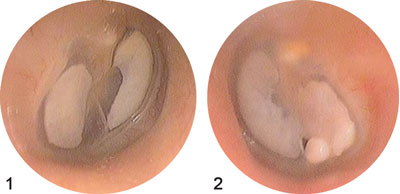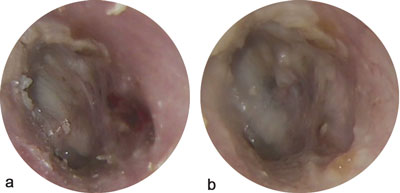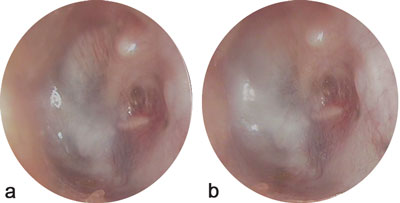Maria Wolniewicz, Elżbieta Niemczyk-Cieślak, *Lidia Zawadzka-Głos
Tympanic membrane reconstruction of a persistent perforation associated with massive myringosclerosis in a girl with achondroplasia – case report
Przetrwała perforacja błony bębenkowej z towarzyszącą masywną myryngosklerozą u dziewczynki z achondroplazją – rekonstrukcja błony bębenkowej. Opis przypadku
Department of Pediatric Otolaryngology, Medical University of Warsaw, Poland
Head of Department: Associate Professor Lidia Zawadzka-Głos, MD, PhD
Streszczenie
Achondroplazja jest chorobą genetyczną związaną z nieprawidłową funkcją receptora dla czynnika wzrostu fibroblastów FGFR3 (Fibroblast growth factor receptor 3). Poza charakterystycznymi nieprawidłowościami w zakresie układu mięśniowo-szkieletowego (niski wzrost, krótkie bliższe odcinki kończyn, wyraźnie zaznaczone czoło, niedorozwój środkowego piętra twarzy, spłaszczony grzbiet nosa) i uogólnioną hipotonią choroba obejmuje także obszar otorynolaryngologii w postaci różnego typu zaburzeń oddychania podczas snu (w tym bezdech obturacyjny oraz centralny) oraz niedosłuchu przewodzeniowego. Zaburzenia te są wynikiem charakterystycznego fenotypu anatomicznego oraz dysfunkcji trąbki słuchowej Eustachiusza. Co ciekawe, nawet 25% dzieci z achondroplazją wykazuje nieprawidłowy wynik przesiewowego badania słuchu na jedno lub dwoje uszu. W większości przypadków występowanie zaburzeń z zakresu otolaryngologii wiąże się z koniecznością przeprowadzenia specjalistycznych zabiegów, zwykle w postaci adenotomii, adenotonsillotomii, tonsillektomii czy drenażu wentylacyjnego. Zabiegi te, szczególnie jeśli wymagają powtarzania interwencji, zwiększają ryzyko powikłań. Przedstawiamy przypadek dziewczynki z achondroplazją zakwalifikowanej do zabiegu rekonstrukcji błony bębenkowej z powodu przetrwałej perforacji błony bębenkowej wskutek przebytego drenażu wentylacyjnego z towarzyszącą masywną myryngosklerozą.
Summary
Achondroplasia is a genetic disease connected with improper function of fibroblast growth factor receptor 3 (FGFR3) resulting in musculoskeletal disorders. Apart from characteristic musculoskeletal abnormalities (short statute with short proximal limb segments, prominent forehead, midface hypoplasia and a depressed nasal bridge) and generalized hypotonia it also affects otolaryngological field in a form of sleep-related upper respiratory tract disorders (obstructive and central apnea) and conductive hearing loss. This is the result of anatomical phenotype, together with Eustachian tube dysfunction. Interestingly, up to 25% of children with achondroplasia may fail hearing screening in one or both ears. In most cases laryngological disorders require surgical procedures, usually adenotomy, adenotonsillectomy, tonsillectomy or tube placement. Such surgical interventions increase the risk of complications, especially when repeated. We would like to present a case of a girl with achondroplasia that was qualified for myringoplasty because of persistent tympanic membrane perforation due to surgical extrusion of persistent ventilation tube, with associated massive myryngoslerosis.
Introduction
Achondroplasia is a genetic disease connected with improper function of fibroblast growth factor receptor 3 (FGFR3) resulting in musculoskeletal disorders (1). Most observed mutation (98%) is one amino-acid-substitution (glycine-to-arginine at position 380), which appears de novo, usually in paternal allele, in up to 80% of cases (2-4).
Anatomical phenotype of people with achondroplasia is characterized by short statute with short proximal limb segments (called rhizomelia), prominent forehead, midface hypoplasia and a depressed nasal bridge. The also present with generalized hypotonia (2-4).
Apart from the musculoskeletal abnormalities it also affects otolaryngological field (5). Patients are typically referred to otolaryngologists due to apnea and milder forms of sleep-related upper respiratory tract disorders or hearing disorders manifesting as conductive hearing loss (5, 6). These problems lead to surgical interventions in up to 64% cases (6): adenotomy, adenotonsillectomy, tonsillectomy or tube placement, usually with the need to be repeated in the future (5, 6). Foramen magnum stenosis, with or without hydrocephalus, is observed in up to 16% of patients, what can lead to central apneas due to cervicomedullary compression (1, 5).
Tunkel et al. reported that 25% of children with achondroplasia failed hearing screening in one or both ears, and about half had abnormal tympanometry (7). According to the multicenter study in the US titled CLARITY (Achondroplasia Natural History Study) gathering 1374 persons with achondroplasia born from 70s till 2010 56.7% of patients had tympanostomy tube placed at least once, among which 57.4% had more than one set placed, and 31.7% had ≥ 3 sets (6). This suggests chronic problem with Eustachian tube function. Other otolaryngological interventions were also observed, but in much lesser percentage, 4.7% underwent eardrum repair of some kind, 2.0% had tracheostomy, other had pharyngoplasty’s, sinus surgeries etc. (6).
Below we would like to present a case of a girl with achondroplasia that was qualified for myringoplasty due to persistent tympanic membrane perforation and massive myryngoslerosis, together with final clinical results.
Case report
A 8-year-old girl with achondroplasia was admitted to the Department of Pediatric Otorhinolaryngology, Medical University of Warsaw due to persistent tympanic membrane perforation. She underwent adenotonsillotomy with bilateral tympanostomy tube placement at the age of almost 2 due to sleep apnea, recurrent respiratory tract infections and conductive hearing loss, complicated by a failure of spontaneous tube extrusion from her left ear. That is why she was qualified for surgical extrusion, which was performed 3 years after insertion. She was then observed in an outpatient clinic for 3 years. As the perforation failed to heal spontaneously, she was qualified for myringoplasty. On admission, she had massive tympanosclerotic plaques bilaterally, with satisfactory healed right tympanic membrane (fig. 1; only focal atrophy in the previous tube setting was marked) and persistent central perforation between inferior quadrants of the left tympanic membrane, surrounded by myryngosclerosis with exophytic formations in the posterior circumference of the left tympanic membrane (fig. 2). The condition of the tympanic membrane with chronic inflammatory changes impairing its flexibility made the reconstruction more challenging. Her preoperative hearing test results showed mild conductive hearing loss of the left ear with normal right ear. Myringoplasty was performed in March 2022. During operation exophytic tympanosclerotic plaque from posteroinferior quadrant, ranging fibrotic annulus was removed. For the reconstruction an underlay technique was used, and as a graft we chose temporal fascia and perichondrium. The dressing was removed 7 days after reconstruction, according to our standard procedure. The process of recovery went without complications, and we were satisfied with the final graft joining (fig. 3a, b, 4a, b). Postoperative hearing results showed equalization of previously observed conductive hearing loss (fig. 5, 6). Our patient remains under ambulatory control.

Fig. 1. Right tympanic membrane – myringosclerotic plaques in posterior and anterior quadrants, marked focal atrophy in the previous tube setting
Fig. 2. Left tympanic membrane – massive myringosclerotic plaques ranging all quadrants and perforation in posteroinferior quadrant, completely surrounded by the plaques

Fig. 3a, b. Left tympanic membrane after myringoplasty, the process of healing: a) 3.5 weeks after surgery, b) 5.5 weeks after surgery

Fig. 4a, b. Left tympanic membrane after myringoplasty, the process of healing – satisfactory graft adhesion (3 months after surgery)

Fig. 5. Tonal audiometry results – 1 day before operation: mild conductive hearing loss of the left ear with normal right ear
Fig. 6. Tonal audiometry results – 3 months after operation: restored conductive hearing gap (air-bone gap) in the left ear after myringoplasty
Discussion
Tympanostomy tube insertion is a common otorhinolaryngological procedure in pediatric population, affecting 8-10% children in the US by the age of 17 (8). In Denmark the incidence seems to be even higher and stands for 30% of children by the age of 5 (8). It is commonly agreed that children who attend daycare institutions and those with craniofacial abnormalities connected with Eustachian tube dysfunction, classically cleft palate, trisomy 21, but also achondroplasia (5-7), are at higher risk of the need for tympanostomy tube placement (8).
Myringoslerosis (up to 32% cases), together with the need for surgical extrusion of persistent tympanostomy tube and persistent tympanic membrane perforation (2% with short-term tubes and up to 16% with long-term tubes) belong to typical complications connected with tympanostomy tube placement (8, 9). Other embrace focal atrophy at the tube placement (25%), tympanostomy tube otorrhea, tube occlusion, premature extrusion, formation of retraction pockets, cholesteatoma, rarely medial displacement (< 0.5%) (8, 9). The risk of their appearance requires the need for regular check-ups after tympanostomy tube placement procedure and early intervention, if needed.
Myringosclerotic plaques may appear in tympanic membranes as a continuum of healing processes of acute otitis media or can represent local inflammatory reaction to persisting foreign body, like tympanostomy tube. It is thought that the increased oxygen concentration in the middle ear is an important factor for plaque formation (10). Once they occur than the usually do not reverse spontaneously – they remain as a „scar” that can remain stable or grow. Fortunately, it seems that they do not always affect hearing tresholds (11), but may cause mild to moderate hearing impairment. According to histopathological analyses they are localized in lamina propria and are formed by hyalinized tissue and accumulation of collagen fibers with focal calcifications (11, 12). Thus, such tympanic membranes are deprived of properly functioning tissue with impaired mobility and proper vascularization. That is why, tympanic membrane perforations with associated massive myringosclerosis pose a challenge for a surgeon performing reconstructive surgery. It is well known that satisfactory healing and graft-adhesion are assured by good vascularization. So, theoretically before graft placement sclerotic plaques should be excised to ensure these conditions, but the more we remove the bigger secondary perforation we create. This is always the question of how far in such „cleaning” should we go so as to finally manage to close the perforation. Migirov and Volkov believe that complete removal of sclerotic plaques is essential, and it enable them 92.5% of myringoplasties’ success (12). However, their study was limited to a small number of cases and due to ethical reasons based on their previous reconstructions they didn’t form a control group with eardrums with plaques, but of those without plaques, which may represent better inborn healing qualities. They also did not mention the problem of massive tympanosclerosis as was observed in our example.
Furukawa et al. described a series of cases like ours, where perforation was completely surrounded by sclerotic plaques. They underlined the need of thorough removal of myringosclerotic deposits from lamina propria at the edge of perforation with the idea of preservation of the mucous and debris layers (11). They also chose underlying technique, but unlike our reconstruction protocol they used fibrin glue to support the graft adhesion (11). Their success rate (meant as a graft-integration) with primary procedure was 91%, one patient required revision surgery, what eventually gave 100% success (11). All patients gained improved air conduction hearing level, together with improved air-bone gap, which were statistically significant. Interestingly, they saved the unexploited fascia in the deep freezer to be used again in unsatisfactory cases (11). We also managed to restore conductive hearing loss in our patient.
Conclusions
Although tympanostomy tube placement belongs to one of the most popular procedures in children’s population we cannot forget that it is also connected with some complications. When considering the proper treatment protocol, it is essential to evaluate the risk factors connected with prolonged Eustachian tube dysfunction, when persisting conductive hearing loss seriously impairs speech and general child’s development.
Some craniofacial abnormalities (e.g. cleft palate) and genetic disorders (e.g. Down syndrome, achondroplasia) may be at risk for the complications of tympanostomy tube placement, especially myringosclerosis and persistent perforations. It is due to persistent Eustachian tube dysfunction leading to repeated procedures and improper tissue formation that impairs wound healing.
Successful tympanic membrane reconstruction requires proper graft choice and adequate healing conditions enabled by good vascularization. This may be impaired when tympanosclerotic plaques are formed, so it is valuable, although it enlarges the perforation, to remove them before the procedure. However, in some severe cases it would mean total eardrum perforation, so we tend to excise those localized directly by the perforation and then refresh the perforation edges thoroughly for better graft-integration results.
Piśmiennictwo
1. Shiang R, Thompson LM, Zhu YZ et al.: Mutations in the transmembrane domain of FGFR3 cause the most common genetic form of dwarfism, achondroplasia. Cell 1994; 78: 335-342.
2. Pauli RM, Achondroplasia: a comprehensive clinical review. Orphanet J Rare Dis 2019; 14(1).
3. Ornitz DM, Legeai-Mallet L: Achondroplasia: Development, pathogenesis, and therapy. Dev Dyn 2017; 246: 291-309.
4. Savarirayan R, Ireland P, Irving M et al.: International Consensus Statement on the diagnosis, multidisciplinary management and lifelong care of individuals with achondroplasia. Nat Rev Endocrinol 2022; 18: 173-189.
5. Collins WO, Choi SS: Otolaryngologic manifestations of achondroplasia. Arch Otolaryngol Head Neck Surg 2007; 133(3): 237-244.
6. Tunkel DE, Gough E, Bober MB et al.: Otolaryngology Utilization in Patients With Achondroplasia: Results From the CLARITY Study. Laryngoscope 2021 Oct 28.
7. Tunkel D, Alade Y, Kerbavaz R et al.: Hearing loss in skeletal dysplasia patient. Am J Med Genet A 2012; 158A(7): 1551-1555.
8. Isaacson GC: Overview of tympanostomy tube placement, postoperative care, and complications in children, UpToDate, Literature review current through: Apr 2022. This topic last updated: Feb 10, 2022.
9. Kay DJ, Nelson M, Rosenfeld RM: Meta-analysis of tympanostomy tube sequelae, Otolaryngol Head Neck Surg 2001; 124(4): 374-380.
10. Mattsson C, Magnuson K, Hellstrom S: Myringosclerosis caused by increased oxygen concentration in traumatized tympanic membranes. Experimental study. Annals of Otology, Rhinology and Laryngology 1995; 104(8): 625-632.
11. Furukawa M, Hayashi C, Narabayashi O et al.: Surgical Management of Myringosclerosis over an Entire Perforated Tympanic Membrane by Simple Underlay Myringoplasty. Int J Otolaryngol 2016.
12. Migirov L, Volkov A: Influence of coexisting myringosclerosis on myringoplasty outcomes in children. J Laryngol Otol 2009; 123(9): 969-972.



